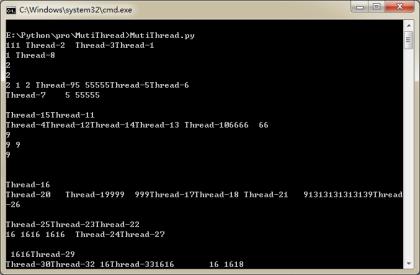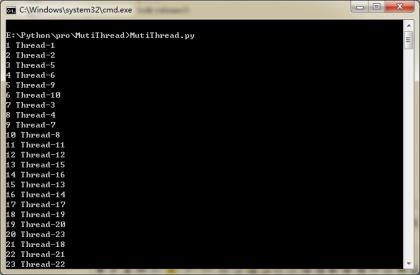Python中多线程及程序锁浅析
Python中多线程使用到Threading模块。Threading模块中用到的主要的类是Thread,我们先来写一个简单的多线程代码:
# coding : uft-8
__author__ = 'Phtih0n'
import threading
class MyThread(threading.Thread):
def __init__(self):
threading.Thread.__init__(self)
def run(self):
global n
print n
n += 1
if "__main__" == __name__:
n = 0
ThreadList = []
for i in range(0, 10):
t = MyThread()
ThreadList.append(t)
for t in ThreadList:
t.start()
for t in ThreadList:
t.join
最普通的一个多线程小例子。我一笔带过地讲一讲,我创建了一个继承Thread类的子类MyThread,作为我们的线程启动类。按照规定,重写Thread的run方法,我们的线程启动起来后会自动调用该方法。于是我首先创建了10个线程,并将其加入列表中。再使用一个for循环,开启每个线程。在使用一个for循环,调用join方法等待所有线程结束才退出主线程。
这段代码看似简单,但实际上隐藏着一个很大的问题,只是在这里没有体现出来。你真的以为我创建了10个线程,并按顺序调用了这10个线程,每个线程为n增加了1.实际上,有可能是A线程执行了n++,再C线程执行了n++,再B线程执行n++。
这里涉及到一个“锁”的问题,如果有多个线程同时操作一个对象,如果没有很好地保护该对象,会造成程序结果的不可预期(比如我们在每个线程的run方法中加入一个time.sleep(1),并同时输出线程名称,则我们会发现,输出会乱七八糟。因为可能我们的一个print语句只打印出一半的字符,这个线程就被暂停,执行另一个去了,所以我们看到的结果很乱),这种现象叫做“线程不安全”:

于是,Threading模块为我们提供了一个类,Threading.Lock,锁。我们创建一个该类对象,在线程函数执行前,“抢占”该锁,执行完成后,“释放”该锁,则我们确保了每次只有一个线程占有该锁。这时候对一个公共的对象进行操作,则不会发生线程不安全的现象了。
于是,我们把代码更改如下:
# coding : uft-8
__author__ = 'Phtih0n'
import threading, time
class MyThread(threading.Thread):
def __init__(self):
threading.Thread.__init__(self)
def run(self):
global n, lock
time.sleep(1)
if lock.acquire():
print n , self.name
n += 1
lock.release()
if "__main__" == __name__:
n = 1
ThreadList = []
lock = threading.Lock()
for i in range(1, 200):
t = MyThread()
ThreadList.append(t)
for t in ThreadList:
t.start()
for t in ThreadList:
t.join()
最后执行结果:

我们看到,我们先建立了一个threading.Lock类对象lock,在run方法里,我们使用lock.acquire()获得了这个锁。此时,其他的线程就无法再获得该锁了,他们就会阻塞在“if lock.acquire()”这里,直到锁被另一个线程释放:lock.release()。
所以,if语句中的内容就是一块完整的代码,不会再存在执行了一半就暂停去执行别的线程的情况。所以最后结果是整齐的。
就如同在java中,我们使用synchronized关键字修饰一个方法,目的一样,让某段代码被一个线程执行时,不会打断跳到另一个线程中。
这是多线程占用一个公共对象时候的情况。如果多个线程要调用多个现象,而A线程调用A锁占用了A对象,B线程调用了B锁占用了B对象,A线程不能调用B对象,B线程不能调用A对象,于是一直等待。这就造成了线程“死锁”。
Threading模块中,也有一个类,RLock,称之为可重入锁。该锁对象内部维护着一个Lock和一个counter对象。counter对象记录了acquire的次数,使得资源可以被多次require。最后,当所有RLock被release后,其他线程才能获取资源。在同一个线程中,RLock.acquire可以被多次调用,利用该特性,可以解决部分死锁问题。
死锁问题很复杂,多年来人们想出了很多算法来解决它。我就不再多说,具体还是要大家参阅帮助文档。

Hot AI Tools

Undresser.AI Undress
AI-powered app for creating realistic nude photos

AI Clothes Remover
Online AI tool for removing clothes from photos.

Undress AI Tool
Undress images for free

Clothoff.io
AI clothes remover

Video Face Swap
Swap faces in any video effortlessly with our completely free AI face swap tool!

Hot Article

Hot Tools

Notepad++7.3.1
Easy-to-use and free code editor

SublimeText3 Chinese version
Chinese version, very easy to use

Zend Studio 13.0.1
Powerful PHP integrated development environment

Dreamweaver CS6
Visual web development tools

SublimeText3 Mac version
God-level code editing software (SublimeText3)

Hot Topics
 1653
1653
 14
14
 1413
1413
 52
52
 1306
1306
 25
25
 1251
1251
 29
29
 1224
1224
 24
24
 PHP and Python: Different Paradigms Explained
Apr 18, 2025 am 12:26 AM
PHP and Python: Different Paradigms Explained
Apr 18, 2025 am 12:26 AM
PHP is mainly procedural programming, but also supports object-oriented programming (OOP); Python supports a variety of paradigms, including OOP, functional and procedural programming. PHP is suitable for web development, and Python is suitable for a variety of applications such as data analysis and machine learning.
 Choosing Between PHP and Python: A Guide
Apr 18, 2025 am 12:24 AM
Choosing Between PHP and Python: A Guide
Apr 18, 2025 am 12:24 AM
PHP is suitable for web development and rapid prototyping, and Python is suitable for data science and machine learning. 1.PHP is used for dynamic web development, with simple syntax and suitable for rapid development. 2. Python has concise syntax, is suitable for multiple fields, and has a strong library ecosystem.
 PHP and Python: A Deep Dive into Their History
Apr 18, 2025 am 12:25 AM
PHP and Python: A Deep Dive into Their History
Apr 18, 2025 am 12:25 AM
PHP originated in 1994 and was developed by RasmusLerdorf. It was originally used to track website visitors and gradually evolved into a server-side scripting language and was widely used in web development. Python was developed by Guidovan Rossum in the late 1980s and was first released in 1991. It emphasizes code readability and simplicity, and is suitable for scientific computing, data analysis and other fields.
 Python vs. JavaScript: The Learning Curve and Ease of Use
Apr 16, 2025 am 12:12 AM
Python vs. JavaScript: The Learning Curve and Ease of Use
Apr 16, 2025 am 12:12 AM
Python is more suitable for beginners, with a smooth learning curve and concise syntax; JavaScript is suitable for front-end development, with a steep learning curve and flexible syntax. 1. Python syntax is intuitive and suitable for data science and back-end development. 2. JavaScript is flexible and widely used in front-end and server-side programming.
 How to run sublime code python
Apr 16, 2025 am 08:48 AM
How to run sublime code python
Apr 16, 2025 am 08:48 AM
To run Python code in Sublime Text, you need to install the Python plug-in first, then create a .py file and write the code, and finally press Ctrl B to run the code, and the output will be displayed in the console.
 Can vs code run in Windows 8
Apr 15, 2025 pm 07:24 PM
Can vs code run in Windows 8
Apr 15, 2025 pm 07:24 PM
VS Code can run on Windows 8, but the experience may not be great. First make sure the system has been updated to the latest patch, then download the VS Code installation package that matches the system architecture and install it as prompted. After installation, be aware that some extensions may be incompatible with Windows 8 and need to look for alternative extensions or use newer Windows systems in a virtual machine. Install the necessary extensions to check whether they work properly. Although VS Code is feasible on Windows 8, it is recommended to upgrade to a newer Windows system for a better development experience and security.
 Where to write code in vscode
Apr 15, 2025 pm 09:54 PM
Where to write code in vscode
Apr 15, 2025 pm 09:54 PM
Writing code in Visual Studio Code (VSCode) is simple and easy to use. Just install VSCode, create a project, select a language, create a file, write code, save and run it. The advantages of VSCode include cross-platform, free and open source, powerful features, rich extensions, and lightweight and fast.
 How to run python with notepad
Apr 16, 2025 pm 07:33 PM
How to run python with notepad
Apr 16, 2025 pm 07:33 PM
Running Python code in Notepad requires the Python executable and NppExec plug-in to be installed. After installing Python and adding PATH to it, configure the command "python" and the parameter "{CURRENT_DIRECTORY}{FILE_NAME}" in the NppExec plug-in to run Python code in Notepad through the shortcut key "F6".




